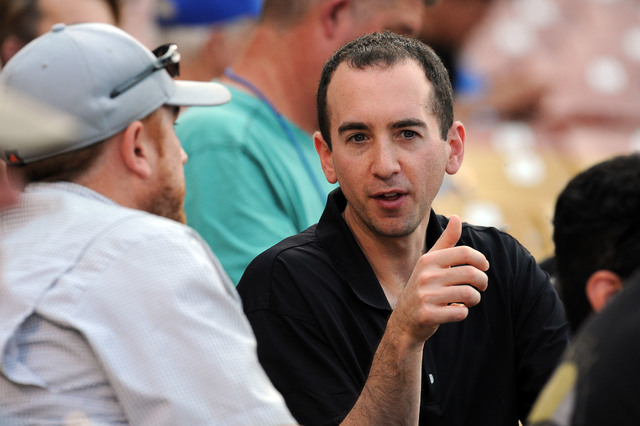For Mets’ boss Levin, it’s all in the numbers

The New York Mets moved their fences in at Citi Field before this season, in part, because of research done by Ian Levin that revealed there would have been 27 more home runs hit — 17 by the Mets — under the new dimensions.
Levin, 30, was named the Mets’ director of minor league operations this year after spending the past two seasons as their manager of baseball analytics — aka sabermetrics, the advanced statistical analysis of the sport.
“For me, it’s information. You’re just trying to get as much information as possible to try to make the best decision you can,” Levin said Friday at Cashman Field, where he spent the past few days with the 51s.
As part of Levin’s new role with the Mets, he oversees the analytics in the minors, where information is harder to come by than in the majors.
“For example, you might not always have pitch-by-pitch data at the minor league level,” he said. “At this level it’s collected, but at the lower levels it’s not, so you try to create that on your own.
“There are different ways to try to understand what the player is all about.”
When it comes to evaluating the 51s, who ply their trades in the hitter-friendly realms of Cashman Field and the Pacific Coast League, Levin takes several factors into consideration.
“You know going into it, it’s a hitter’s league and a hitter’s park, so you have to adjust the numbers accordingly,” he said “Just like you do at the major league level for the (Colorado) Rockies. They play in a hitting environment, so they have to make adjustments for their numbers on their guys, and we’ll do the same thing on our guys.
“You try to figure out how much more friendly this place is to hit in than another environment.”
Besides adjusting numbers based on the ballpark, Levin said he also looks for “building blocks of quality performance.”
“Is the guy striking out a lot? As a hitter, that’d be a negative. Or, as a pitcher, is he striking hitters out? Because those things have less to do with the environment,” he said. “You look for things that don’t have as much to do with the environment that you can try to begin to put the picture together for the player.”
The Mets are one of the biggest believers in analytics. New York general manager Sandy Alderson mentored Oakland GM Billy Beane, the main character in the movie “Moneyball,” which focused on the Athletics’ analytical approach to building a competitive team on a limited budget.
“I don’t want to compare us to any other teams. I just know we’re happy with what our process is. We try to get as much information as possible,” said Levin, a Seton Hall graduate. “Sandy’s great in that he gives everyone in the office the ability to have input, or kind of explore ideas on their own. He does an amazing job taking in all the information and making the ultimate decision.”
After six straight losing seasons, the Mets (16-9), buoyed by an abundance of homegrown talent, have one of the best records in baseball this season and one of the top farm systems as well.
“The dream for any (big league) team is to have an entirely homegrown team,” Levin said. “You want guys who have come through your system and know each other, and we’re close to that.”
Coming off a year in which all seven of their minor league affiliates finished at .500 or better and combined for the best winning percentage (.568) in baseball, the Mets are ranked fifth in Baseball America’s organizational talent rankings.
“Hopefully we can repeat our success from last year, but it’s about more than just winning,” Levin said. “It’s also about producing major leaguers, and we’ve been doing that.”
Under manager Wally Backman, the 51s have posted back-to-back 81-win seasons and division titles while sending a plethora of players to New York — including pitcher Jacob deGrom, last year’s National League Rookie of the Year.
Las Vegas (15-8) shows no signs of slowing down this season. The 51s already have sent five players to the Mets and notched their ninth straight win in Saturday’s 3-0 victory over Reno before 5,040 at Cashman.
“Right now, they’re leading all of Triple A in like every offensive category, and their arms are good, too,” Levin said.
That’s a bit of an understatement. Left-hander Steven Matz (3-1, 1.84 ERA) — the Mets’ No. 2 prospect whose pro debut was delayed for three years by complications from Tommy John surgery — has allowed one run in his past two starts with 17 strikeouts and three walks in 14 innings.
“He’s outstanding, especially the work ethic he has to come back from the injuries he had early in his career,” Levin said. “That’s a huge testament to him. We’re thrilled with what he’s done.”
Right-hander Noah Syndergaard (2-0, 1.66 ERA) — New York’s No. 1 prospect — scattered four hits in seven scoreless innings Saturday with 10 strikeouts and two walks after tossing a two-hit shutout Monday with nine strikeouts and no walks.
“He’s been great. He’s a hard worker, and his stuff is outstanding,” Levin said of the 22-year-old. “He’s moved quickly through the system. It’s his second year in Triple A, but he’s still so young for the (PCL) and his stuff is so advanced. He’s a special prospect, too.”
Levin laughed when asked if there were any plans to move the fences back at Cashman.
“That would make it less of a hitting environment,” he said.
Contact reporter Todd Dewey at tdewey@reviewjournal.com or 702-383-0354. Follow him on Twitter: @tdewey33.